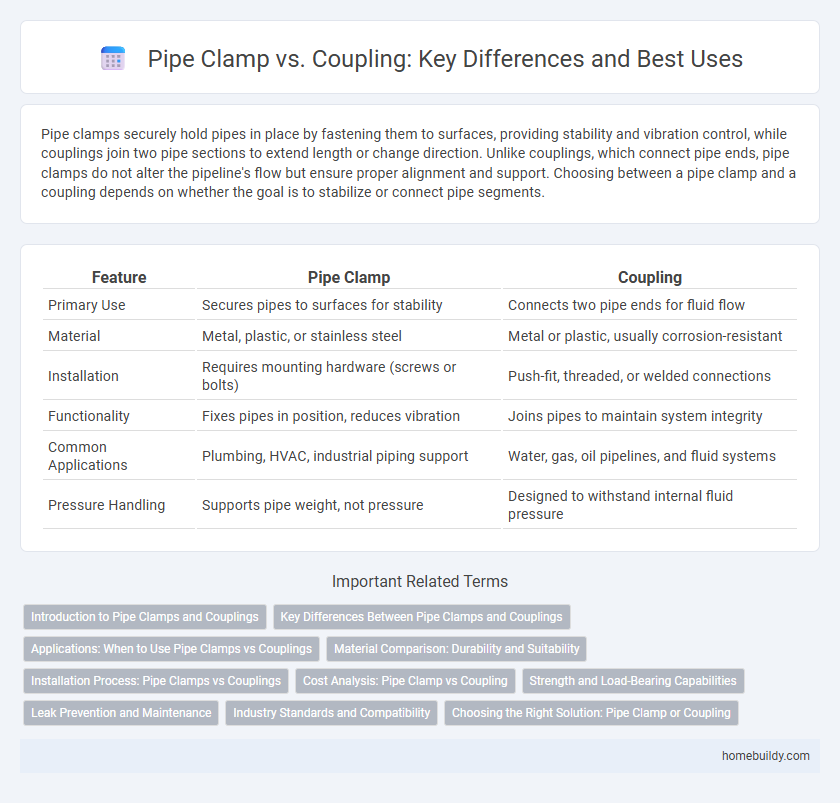Pipe clamps securely hold pipes in place by fastening them to surfaces, providing stability and vibration control, while couplings join two pipe sections to extend length or change direction. Unlike couplings, which connect pipe ends, pipe clamps do not alter the pipeline's flow but ensure proper alignment and support. Choosing between a pipe clamp and a coupling depends on whether the goal is to stabilize or connect pipe segments.
Table of Comparison
| Feature | Pipe Clamp | Coupling |
|---|---|---|
| Primary Use | Secures pipes to surfaces for stability | Connects two pipe ends for fluid flow |
| Material | Metal, plastic, or stainless steel | Metal or plastic, usually corrosion-resistant |
| Installation | Requires mounting hardware (screws or bolts) | Push-fit, threaded, or welded connections |
| Functionality | Fixes pipes in position, reduces vibration | Joins pipes to maintain system integrity |
| Common Applications | Plumbing, HVAC, industrial piping support | Water, gas, oil pipelines, and fluid systems |
| Pressure Handling | Supports pipe weight, not pressure | Designed to withstand internal fluid pressure |
Introduction to Pipe Clamps and Couplings
Pipe clamps secure pipes by providing stable support and vibration reduction, essential in plumbing and construction systems. Couplings join two pipe sections, enabling fluid or gas flow continuity and facilitating pipe length extension or repair. Both components ensure system integrity but serve distinct roles in pipe assembly and maintenance.
Key Differences Between Pipe Clamps and Couplings
Pipe clamps secure pipes to structures, providing stability and reducing movement, while couplings join two pipe segments to extend length or change direction. Pipe clamps typically consist of a metal band with a screw for tightening, designed for external support, whereas couplings are tubular fittings that create a sealed connection between pipe ends. The primary difference lies in function: clamps stabilize existing pipes; couplings connect pipes for fluid or gas flow continuity.
Applications: When to Use Pipe Clamps vs Couplings
Pipe clamps are ideal for securing pipes to walls or structures, providing stability and support in plumbing, HVAC, and construction projects. Couplings are used to connect two pipe sections together, ensuring a continuous flow and structural integrity in piping systems across various industries. Use pipe clamps for fixed installations and couplings when extending or repairing pipe runs.
Material Comparison: Durability and Suitability
Pipe clamps are typically made from stainless steel, carbon steel, or plastic, offering excellent corrosion resistance and flexibility for securing pipes in various environments. Couplings often utilize materials like ductile iron, steel, or PVC, designed for joining pipe sections with high tensile strength and leak-proof performance. Stainless steel pipe clamps provide superior durability in harsh conditions, while ductile iron couplings excel in heavy-duty applications requiring robust strength and pressure resistance.
Installation Process: Pipe Clamps vs Couplings
Pipe clamps offer a straightforward installation process involving wrapping the clamp around the pipe and tightening bolts to secure it without requiring pipe alignment, making them ideal for quick repairs and adjustable fittings. Couplings demand precise alignment of pipe ends and often need welding, threading, or solvent cementing, which extends installation time but ensures a permanent, leak-proof connection. The choice between pipe clamps and couplings depends on the application's need for flexibility versus a sealed, durable joint.
Cost Analysis: Pipe Clamp vs Coupling
Pipe clamps generally offer a more cost-effective solution for securing pipes compared to couplings, particularly in applications requiring frequent adjustments or removals. The initial investment in pipe clamps is lower due to simpler design and reduced material usage, while couplings often incur higher costs due to their complexity and sealing capabilities. Maintenance expenses also favor pipe clamps as they typically allow quicker access for inspection and repairs, minimizing labor time and associated costs.
Strength and Load-Bearing Capabilities
Pipe clamps provide superior load-bearing capabilities by securely fastening pipes to structures, distributing weight evenly and reducing stress points. Couplings primarily join pipe sections end-to-end, lacking the structural reinforcement that pipe clamps offer for weight support. Strength in pipe clamps comes from robust materials such as stainless steel, designed to handle dynamic loads and vibrations, unlike most couplings.
Leak Prevention and Maintenance
Pipe clamps provide superior leak prevention by securely fastening pipes and absorbing vibrations, reducing stress at joint connections compared to couplings. Unlike couplings, which primarily join pipe sections, clamps allow easier access for maintenance and inspections without disassembly. Their robust design minimizes pipe movement, enhancing system reliability and reducing the risk of leaks over time.
Industry Standards and Compatibility
Pipe clamps and couplings differ significantly in industry standards and compatibility; pipe clamps typically adhere to ASTM F843 and DIN 3015 standards, ensuring secure fastening for pipes in HVAC and plumbing applications. Couplings, governed by ANSI B16.9 and ISO 49 standards, provide a sealed connection between pipes of the same or different dimensions, allowing for pressure-rated performance in fluid transport systems. Compatibility considerations require selecting pipe clamps for support and vibration control, while couplings are chosen for joining pipes under standardized pressure and temperature conditions.
Choosing the Right Solution: Pipe Clamp or Coupling
Pipe clamps provide secure mechanical support and flexibility for pipe alignment, making them ideal for structural stability and vibration reduction in piping systems. Couplings are designed to join two pipe ends permanently or semi-permanently, ensuring leak-proof connections and facilitating quick assembly or disassembly. Choosing the right solution depends on whether the priority is mechanical support and adjustability (pipe clamp) or seamless pipe connection and flow integrity (coupling).
Pipe clamp vs Coupling Infographic

 homebuildy.com
homebuildy.com